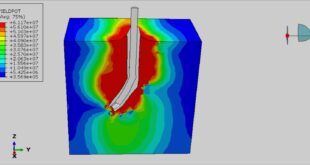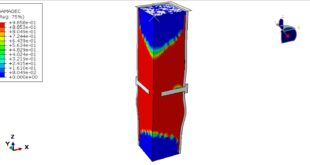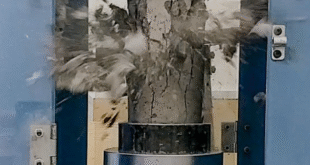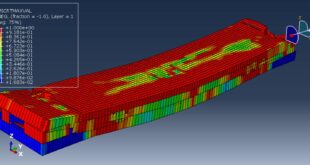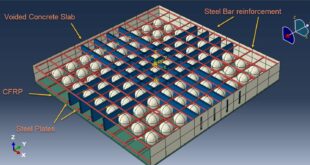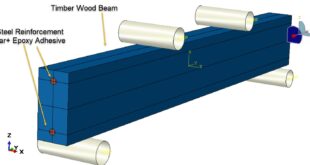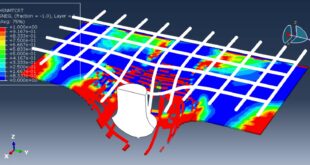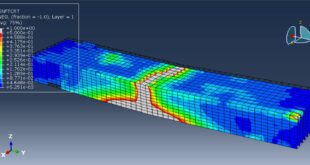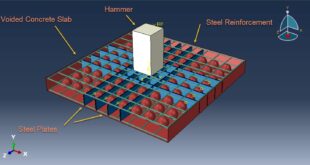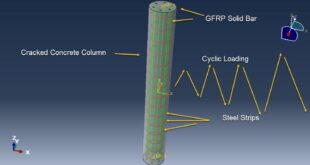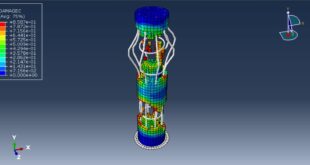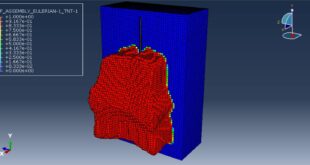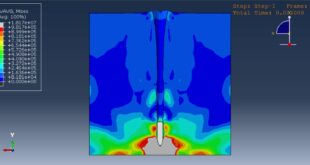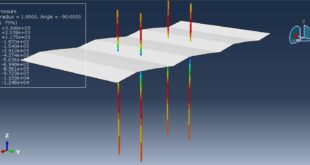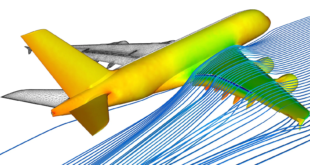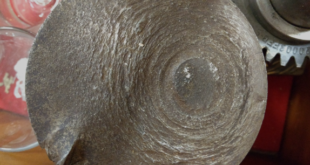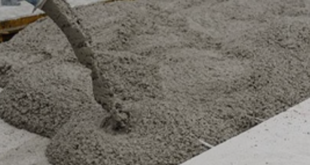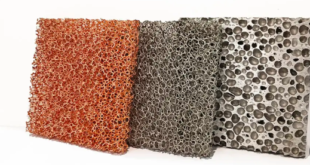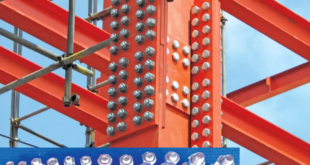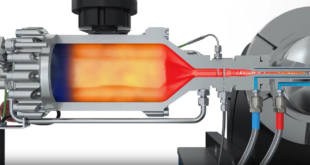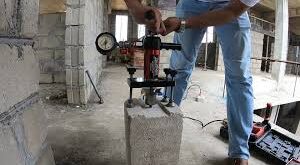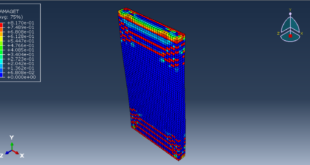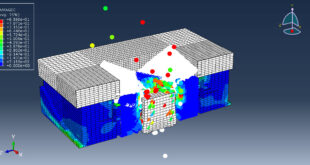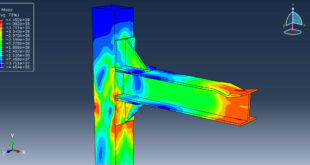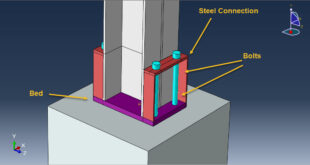Introduction to Pull-out Test Analysis of a Hooked GFRP Bar Embedded in Timber with Epoxy Interface Background and Significance Fiber-reinforced polymer (FRP) bars, particularly glass-FRP (GFRP), are increasingly used as reinforcement in timber structures due to their high strength-to-weight ratio, corrosion resistance, and compatibility with wood. However, the bond behavior ...
ادامه نوشته »Simulation of bolts used as shear connectors in concrete-filled steel column in Abaqus
Introduction to Bolts as Shear Connectors in Concrete-Filled Steel Columns Overview In concrete-filled steel tube (CFST) columns, shear connectors are crucial for ensuring composite action between the steel tube and the enclosed concrete core. Bolts are increasingly used as shear connectors due to their ease of installation, adjustability, and effectiveness in transferring shear forces Role ...
ادامه نوشته »Concrete cylinder compression test under static and dynamic load in Abaqus
Introduction to the Concrete Cylinder Compression Test The concrete cylinder compression test is a standard method used to determine the compressive strength of hardened concrete, which is a key indicator of its quality and structural performance. This test is performed according to established standards such as ASTM C39 (American Society for Testing and Materials) or EN 12390-3 ...
ادامه نوشته »Simulation blast resistance behavior of adhesively bonded cross-laminated timber-concrete composite
Introduction to Simulation of Blast Resistance Behavior of Adhesively Bonded Cross-Laminated Timber-Concrete Composite (CLT-CC) Overview The simulation of blast resistance behavior in adhesively bonded cross-laminated timber-concrete composites (CLT-CC) represents an emerging area of research in structural engineering and blast mitigation. This composite system combines the advantages of cross-laminated timber (CLT) ...
ادامه نوشته »Blast resistance behavior of interior voided slab-column connections using steel sheets and CFRP reinforcement
Introduction to Blast Resistance Behavior of Interior Voided Slab-Column Connections Using Steel Sheets and CFRP Reinforcement Background and Significance Modern structures, particularly those in high-risk environments, require enhanced resistance to extreme loading conditions such as blast loads. Slab-column connections are critical zones in reinforced concrete (RC) frames, often susceptible to ...
ادامه نوشته »Flextural test of timber beams reinforced with steel bars and epoxy in Abaqus
Introduction to Flexural Testing of Timber Beams Reinforced with Steel Bars Overview The flexural test of timber beams reinforced with steel bars is an experimental procedure used to evaluate composite timber-steel structural elements’ bending strength, stiffness, and ductility. This test is essential for assessing how steel reinforcement enhances the mechanical ...
ادامه نوشته »Ballistic impact on the hybrid fiber reinforced concrete reinforced with CFRP sheet
Introduction to Bullet Ballistic Impact on Hybrid Fiber-Reinforced Concrete (HFRC) Reinforced with CFRP Sheets Background Hybrid Fiber-Reinforced Concrete (HFRC) combines different types of fibers (e.g., steel, polypropylene, basalt, or glass) to enhance mechanical properties such as tensile strength, ductility, and impact resistance. When further reinforced with Carbon Fiber-Reinforced Polymer (CFRP) ...
ادامه نوشته »Flexural behavior of adhesively bonded cross-laminated timber-ultra high performance concrete composite panel
Flexural Behavior of Adhesively Bonded Cross-Laminated Timber–Ultra-High-Performance Concrete (CLT-UHPC) Composite Panels Introduction Composite structural systems combining cross-laminated timber (CLT) and ultra-high-performance concrete (UHPC) have gained attention due to their potential to enhance structural efficiency, sustainability, and performance. CLT provides a high strength-to-weight ratio, carbon sequestration benefits, and ease of prefabrication, while UHPC contributes ...
ادامه نوشته »Low-Velocity impact behavior of interior voided slab-column connections using steel sheets in Abaqus
Introduction to Low-Velocity Impact Behavior of Interior Voided Slab-Column Connections Using Steel Sheets Background Slab-column connections are critical structural elements in modern construction, particularly in flat-plate systems where shear resistance and punching strength are major concerns. Introducing voids within the slab (voided slabs) can reduce weight, improve material efficiency, and ...
ادامه نوشته »Simulation flexural behavior of steel-polypropylene hybrid fiber reinforced concrete reinforced with GFRP sheet in Abaqus
Introduction to Flexural Behavior of Steel-Polypropylene Hybrid Fiber Reinforced Concrete Reinforced with GFRP Sheet The flexural behavior of steel-polypropylene hybrid fiber reinforced concrete (SP-HFRC) reinforced with glass fiber reinforced polymer (GFRP) sheets represents an advanced composite material system that combines multiple reinforcement mechanisms to improve the mechanical performance of concrete ...
ادامه نوشته »Cyclic loading analysis of a cracked and damaged concrete column reinforced with GFRP bar
Introduction to Cyclic Loading Analysis of a Cracked Concrete Column Reinforced with GFRP Bars in Abaqus Cyclic loading analysis of damaged concrete columns reinforced with Glass Fiber-Reinforced Polymer (GFRP) bars is an important simulation for evaluating seismic performance and rehabilitation strategies. This analysis helps engineers understand how cracked concrete structures ...
ادامه نوشته »Finite element analysis of hybrid jute/basalt fiber reinforced polymer confined UHPC column under axial compression
Introduction to Finite Element Analysis of Hybrid Jute/Basalt Fiber Reinforced Polymer Confined UHPC Column under Axial Compression in Abaqus Overview of the Study Ultra-High Performance Concrete (UHPC) is known for its exceptional strength, durability, and ductility, making it suitable for high-performance structural applications. However, to further enhance its load-bearing capacity ...
ادامه نوشته »Numerical study on CFRP-lined concrete cylinder pipe under internal explosion
Introduction to Numerical Study on CFRP-Lined Concrete Cylinder Pipe (CCP) Under Internal Explosion Concrete Cylinder Pipes (CCPs) are widely used in water transmission systems due to their high load-bearing capacity and durability. However, they are vulnerable to internal explosions caused by accidental gas ignition or deliberate attacks, leading to catastrophic ...
ادامه نوشته »Simulation shock pressure and shock-wave attenuation near a blast hole in rock in Abaqus
In this practical example, the Simulation shock pressure and shock-wave attenuation near a blast hole in rock in Abaqus has been investigated. The CEL approach is selected to model the blast load in the borehole. You can see a figure of the assembled parts below When an explosive detonates in ...
ادامه نوشته »Bullet penetration models using large deformation explicit finite element simulations of rapid penetration in soil
In this tutorial, the Bullet penetration model using large deformation explicit finite element simulations of rapid penetration in soil in Abaqus software has been studied. The bullet is modeled as a three-dimensional part, and the soil as an Eulerian model. You can see a figure of the assembled parts below ...
ادامه نوشته »Abaqus AQUA- a Riser Group under current, wave, and drag load analysis
Abaqus AQUA is a specialized module within the SIMULIA Abaqus finite element analysis (FEA) software that simulates the effects of hydrodynamic loads on offshore and marine structures. It is beneficial for analyzing structures exposed to waves, currents, and buoyancy forces, such as Offshore platforms (oil & gas rigs, wind turbines) Subsea pipelines Ship components Floating structures ...
ادامه نوشته »Fluid-Structure Interaction (FSI) and CFD Analysis Package in Abaqus
Fluid-Structure Interaction (FSI) and CFD Analysis in Abaqus Introduction to Fluid-Structure Interaction (FSI) Fluid-Structure Interaction (FSI) is a multiphysics phenomenon where a fluid and a solid structure interact, leading to deformation in the structure and changes in the fluid flow. FSI problems are common in engineering applications such as Aerodynamics ...
ادامه نوشته »Ceramic and Silicon Carbide Package in Abaqus
Introduction to Ceramic and Silicon Carbide Materials Ceramics are inorganic, non-metallic materials known for their high hardness, thermal stability, and chemical resistance. They are typically made by heating natural minerals (like clay) or synthetic powders at high temperatures (sintering). Silicon carbide is an advanced ceramic and semiconductor material composed of ...
ادامه نوشته »Fatigue and Cyclic Loading Package in Abaqus
Fatigue and Cyclic Loading in Abaqus Mechanical fatigue is a phenomenon where a material undergoes progressive and localized structural damage when subjected to cyclic or fluctuating stresses, even if these stresses are below the material’s ultimate tensile strength. Over time, this repeated loading and unloading can lead to the initiation ...
ادامه نوشته »Ultra-High-Performance-Concrete(UHPC) Package in Abaqus
Introduction to Ultra-High-Performance Concrete (UHPC) in Abaqus Ultra-high-performance concrete (UHPC) is an advanced cementitious material characterized by its exceptional strength, durability, and ductility. It typically has a compressive strength exceeding 150 MPa and can reach up to 250 MPa or higher, along with superior tensile strength and resistance to environmental ...
ادامه نوشته »Polymer and Metal Foam Simulation Package-Abaqus
Introduction to Polymeric and Metal Foam Simulation in Abaqus Polymeric and metal foam are advanced materials widely used in industries such as aerospace, automotive, biomedical, and construction due to their unique properties, including high strength-to-weight ratios, energy absorption, and thermal and acoustic insulation. Simulating these materials in Abaqus, a powerful ...
ادامه نوشته »Bolt Analysis and Simulation Package-Abaqus
Introduction to Bolt Analysis in Abaqus Abaqus is a powerful finite element analysis (FEA) software widely used for simulating complex mechanical systems, including bolted joints. Bolt analysis in Abaqus involves modeling the bolt, applying preload, and simulating the behavior of the bolted joint under various loading conditions. This analysis helps ...
ادامه نوشته »Rock and Stone Analysis Package in Abaqus
Introduction to Rock and Stone Simulation and Analysis in Abaqus Rock and stone analysis in Abaqus software involves simulating the mechanical behavior of geological materials, such as rocks, stones, and other geomaterials, under various loading and environmental conditions. Abaqus, a powerful finite element analysis (FEA) software, is widely used in ...
ادامه نوشته »Cold Spray Simulation and Analysis Package-Abaqus
Introduction to Cold Spray Process The cold spray process is an advanced additive manufacturing and coating technology that involves the deposition of solid powder particles onto a substrate at high velocities but relatively low temperatures. Unlike traditional thermal spray methods, which often involve melting or significant heating of the feedstock material, ...
ادامه نوشته »Pull-Out Test Package in Abaqus
Introduction to Pull-Test Simulation in Abaqus Pull-test simulation in Abaqus is a computational method used to analyze the mechanical behavior of materials and structures under tensile loading. This type of simulation is commonly employed in various industries, including aerospace, automotive, and civil engineering, to predict the performance and failure mechanisms ...
ادامه نوشته »Glass Simulation and Analysis Package in Abaqus
Introduction to Glass Simulation and Analysis in Abaqus Abaqus, a powerful finite element analysis (FEA) software developed by Dassault Systèmes, is widely used for simulating and analyzing complex mechanical behaviors in various materials, including glass. Glass, being a brittle material with unique properties such as transparency, hardness, and low ductility, ...
ادامه نوشته »Simulation Wood-Cement wall under seismic loading in Abaqus
In this tutorial, the Simulation Wood-Cement wall under seismic loading in Abaqus has been investigated. The wood-cement wall is modeled as a three-dimensional solid part. The steel reinforcements are modeled as wire parts. You can see a figure of the assembled parts below Bio-sourced materials combined with a cementitious matrix ...
ادامه نوشته »Strengthening of reinforced concrete columns incorporating different configurations of stainless-steel plates
In this tutorial, the Strengthening of reinforced concrete columns incorporating different configurations of stainless-steel plates has been investigated. The concrete column, steel plates, and rods are modeled as three-dimensional solid parts. The steel bar and strips are modeled as wire parts. You can see figures of the assembled parts below ...
ادامه نوشته »Simulation of defected RC beam with sustainable aluminum boxes incorporating ultra-high-performance concrete in Abaqus
In this tutorial, the ُSimulation of defected RC beam with sustainable aluminum boxes incorporating ultra-high-performance concrete in Abaqus has been investigated. The concrete beam, UHPC members, and aluminum boxes are modeled as three-dimensional solid parts. The steel reinforcements are modeled as wire parts. You can see figures of the assembled ...
ادامه نوشته »Using ceramic plates as shielding for concrete blocks against projectile penetration-SPH method
In this tutorial, the Simulation of ceramic plates as shielding for concrete blocks against projectile penetration(SPH method) has been done. The ceramic plate and Ultra-High-Performance-Concrete are modeled as three-dimensional solid parts. The bullet is modeled as a solid part. You can see a figure of the assembled parts below In ...
ادامه نوشته »Simulation cyclic loading of a steel beam-column joint with welded steel angle and stiffeners in Abaqus
In this tutorial, the Simulation cyclic loading of a steel beam-column joint with welded steel angle and stiffeners in Abaqus. Box column, steel beam angles, and stiffeners are modeled as the three-dimensional solid part. If a structural steel member is subjected to a cyclically varying load of sufficient amplitude it ...
ادامه نوشته »Cyclic behavior of exposed base plates with extended anchor bolts in Abaqus
Column base connections are among the most critical components of Steel Moment Frames, their behavior profoundly influences the overall performance of SMFs. Early investigations on Column-base connections alongside remarkable experimental programs on large-scale specimens. have provided insight into their behavior and failure modes. These tests led to the development of ...
ادامه نوشته » Abaqus tutorials Abaqus tutorials
Abaqus tutorials Abaqus tutorials
